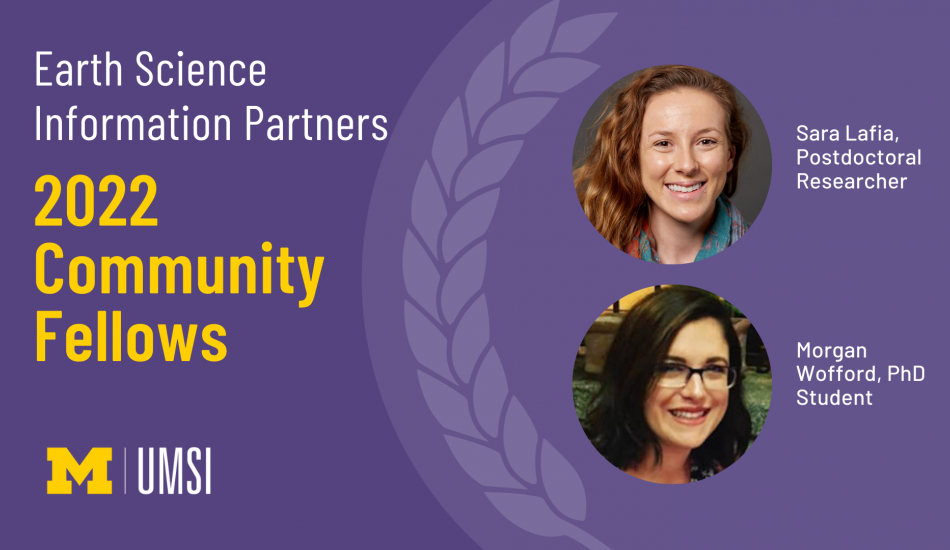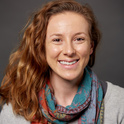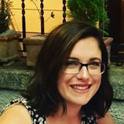
University of Michigan School of Information postdoctoral research fellow Sara Lafia and PhD student Morgan Wofford were named 2022 Earth Science Information Partners (ESIP) Community Fellows. Fellowships are awarded to graduate students and postdoctoral researchers who are interested in bridging the gap between informatics and earth science.
ESIP is a non-profit, interdisciplinary organization created by NASA in 1998. Their partners include federal data centers, government research laboratories, research universities, education resource providers, technology developers and various nonprofit and commercial enterprises. ESIP’s goal is to be a leader in promoting the collection, stewardship and use of earth science data, information and knowledge that is responsive to societal needs.
Andrea Thomer, assistant professor of information and former ESIP fellow, says participating in ESIP has been invaluable in her career. “My ESIP fellowship really opened new doors for me, both in terms of meeting new people at all sorts of organizations, and in introducing me to new ideas and fields of study,” she says.
Thomer adds that earth science has innovated informatics for a long while. “NASA, for instance, has always had massive amounts of data to analyze and manage, and actually developed some of the earliest guidelines for digital repository development.” She adds that keeping these fields closely aligned is important for innovations in both.
“Sara and Morgan are both stellar interdisciplinary scholars doing unique and needed work in data curation and open science,” Thomer says. “Sara’s work bridges geography, data science and earth science, and Morgan brings expertise from wildlife biology to information science.”
Meet the ESIP fellows

postdoctoral research fellow
You were a fellow last year as well. Is your research a continuation of previous efforts or are you investigating something new?
Last year as an ESIP fellow, I worked with ESIP’s Discovery cluster on a tool to help people find relevant earth science data through the applications that use the data. To create examples of “usage-based” data discovery, I worked with scientists from NASA, NOAA (National Oceanic and Atmospheric Administration) and the USGS (United States Geological Survey) to collect academic publications that use earth science datasets, which were added to the tool.
This year, I am working with ESIP’s Semantic Technology cluster (a working group focusing on the adoption of semantic technologies in the earth science community) to support data managers who want to develop and apply controlled vocabularies to coordinate their work across organizations.
What are you working on?
The Semantic Technology cluster maintains a large earth science vocabulary called the SWEET (Semantic Web for Earth and Environment Technology) ontology. I am working with the cluster to develop user-guides, tutorials, and a library of web resources for SWEET.
The main issue our cluster is working on is developing educational materials to help data managers work with linked data and contribute to our community. This is a relatively new technology and there’s a lot of need to develop use cases so data managers can learn about best practices for working with Semantic Web technologies. Lowering the barrier to adopt linked data — such as field expeditions, journal publications, grants, observations — makes it easier for data providers to adopt community standards. It also makes it easier for users to find earth science observations across providers and subject areas, like facility emissions data and climate records.
How does the ESIP Fellowship help you in your research/career/outreach?
My involvement with ESIP as a graduate student and postdoc has provided me with excellent networking and professional development opportunities. I’ve also connected with other scientists who are passionate about data curation and shared ideas for measuring the impact of curation on data reuse, which is the focus of my current research at ICPSR (Inter-university Consortium for Political and Social Research) at the University of Michigan.

UMSI PhD student
How did you learn about ESIP Fellowship?
I learned about the ESIP fellowship through my advisor, Andrea Thomer, who was an ESIP fellow when she was a Ph.D. candidate.
What are you working on?
As a fellow, I will primarily support the Community Resilience collaboration area. We are working to enhance community resilience through culturally meaningful improvements to earth science data accessibility and informatics tools. Community resilience increases a place-based community’s capacity to respond and adapt to life-changing environmental dynamics like climate change, natural disasters and pollution. We aim to support earth science’s understanding of the challenges communities face when applying Earth science data to their resilience efforts. At the same time, we are building connections between community resilience and other ESIP areas as various groups increasingly work with place-based communities. Specifically, we hope to integrate community participation into the scientific data workflows through these connections.
How does ESIP Fellowship help you in your research/career/outreach?
I have a background in the natural sciences and hope to increasingly bring that into my research, and ESIP provides me the avenue to do that. I am presently examining how open data moves outside of conventional research communities. How can we create equitable and culturally meaningful access to data while minimizing intentional and unintentional misuse? The community resilience collaboration areas align with my interests in understanding the realities of open data and actualizing its promises.
Contact: Sarah Derouin, UMSI public relations specialist


